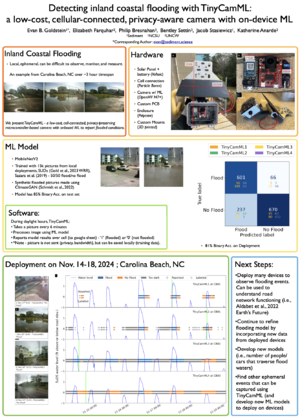2025 CSDMS meeting-081
From CSDMS
(if you haven't already)
Log in (or create account for non-CSDMS members)
Forgot username? Search or email:CSDMSweb@colorado.edu
Browse abstracts
Detecting inland coastal flooding with TinyCamML, a low-cost, privacy-aware camera with on-device ML and cellular connectivity
Evan Goldstein,
(he/him),Sediment, LLC Greensboro North Carolina, United States. evan@sediment.science
Elizabeth Farquhar, NC State University , United States.
Philip Bresnahan, UNC Wilmington , United States.
Bentley Settin, UNC Wilmington , United States.
Jacob Stasiewicz, Sediment, LLC , United States.
Katherine Anarde, NC State University , United States.
Chronic coastal flooding, or flooding that occurs outside of extreme storm events, can impact a community’s ability to access homes, businesses, roads, and/or other necessary infrastructure. The drivers of chronic coastal flooding can be highly local, making it difficult to predict the full spatial and temporal extent of flooding. In our poster we introduce an easily maintainable camera system that we have developed to monitor flooding in coastal regions. Our device - a Tiny Camera with Machine Learning, or TinyCamML - is a small, solar-powered, low- cost (<$400), microcontroller-based camera that uses on-device machine learning to classify images (taken every 6 minutes) as “Flooded” or “Not Flooded.” TinyCamMLs transmit – in real-time via cellular network - only the classifications to a website, providing situation awareness during flood events. Images are never transmitted (and can be set up to not even be saved), protecting the privacy of the local communities in which they are deployed. We provide information on the device, developing the (quantized) ML model, and show results from our test deployments in North Carolina. The camera system could easily be adapted to host other ML models designed to capture or measure various Earth surface processes.

